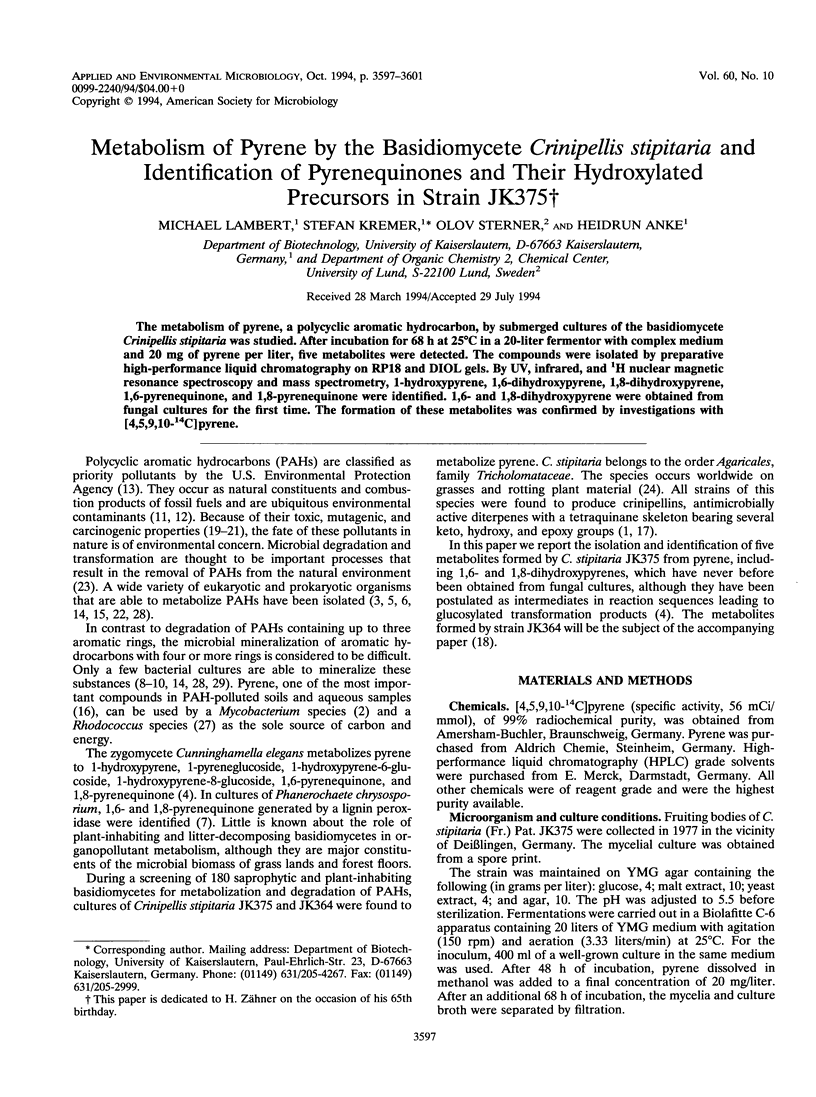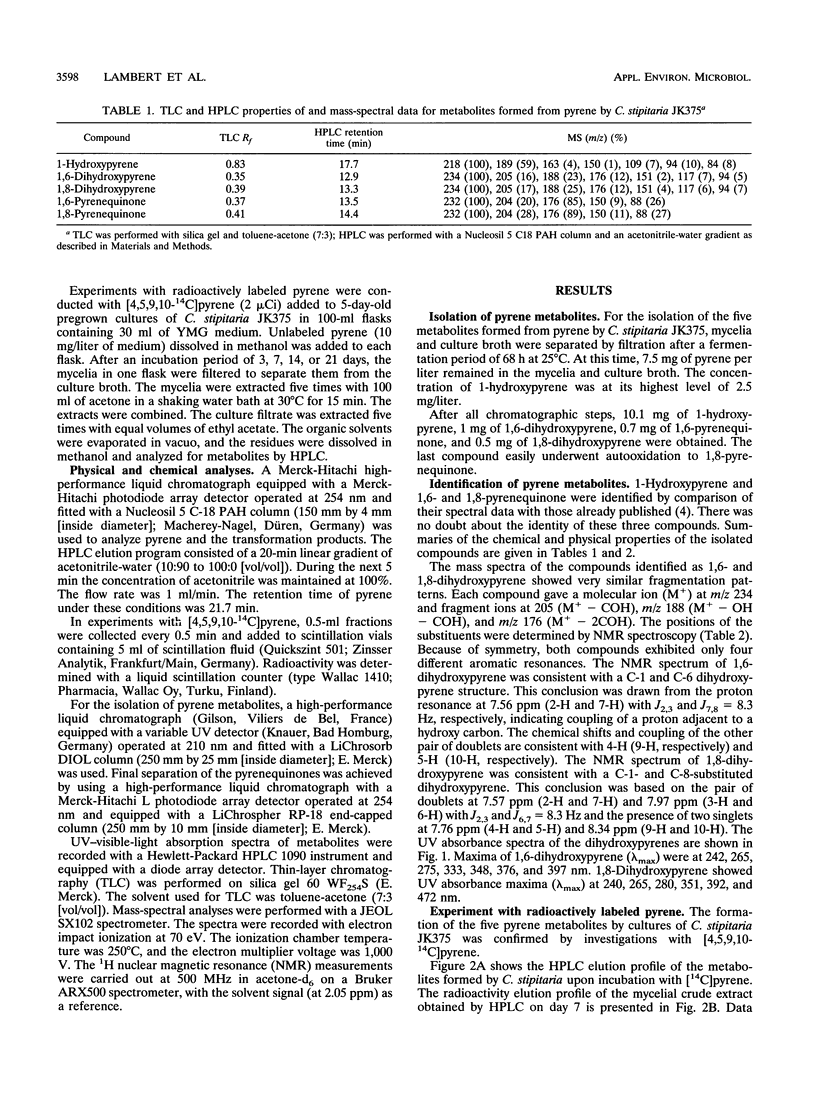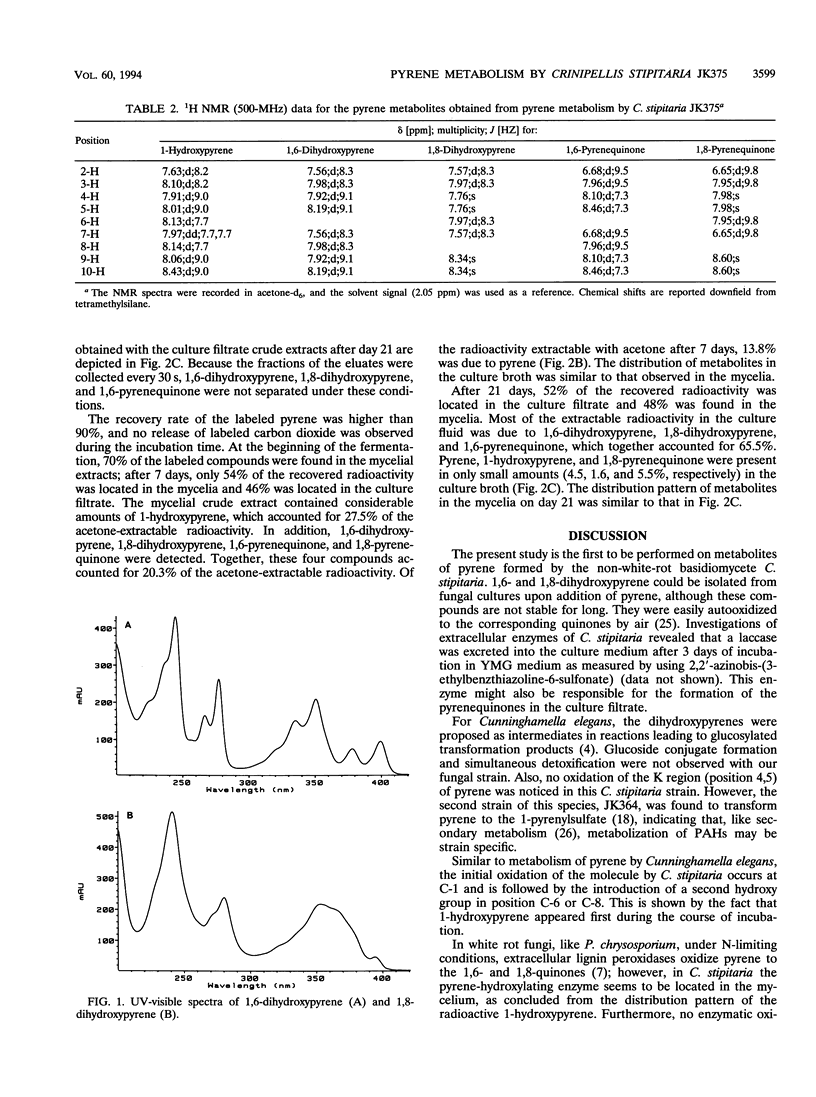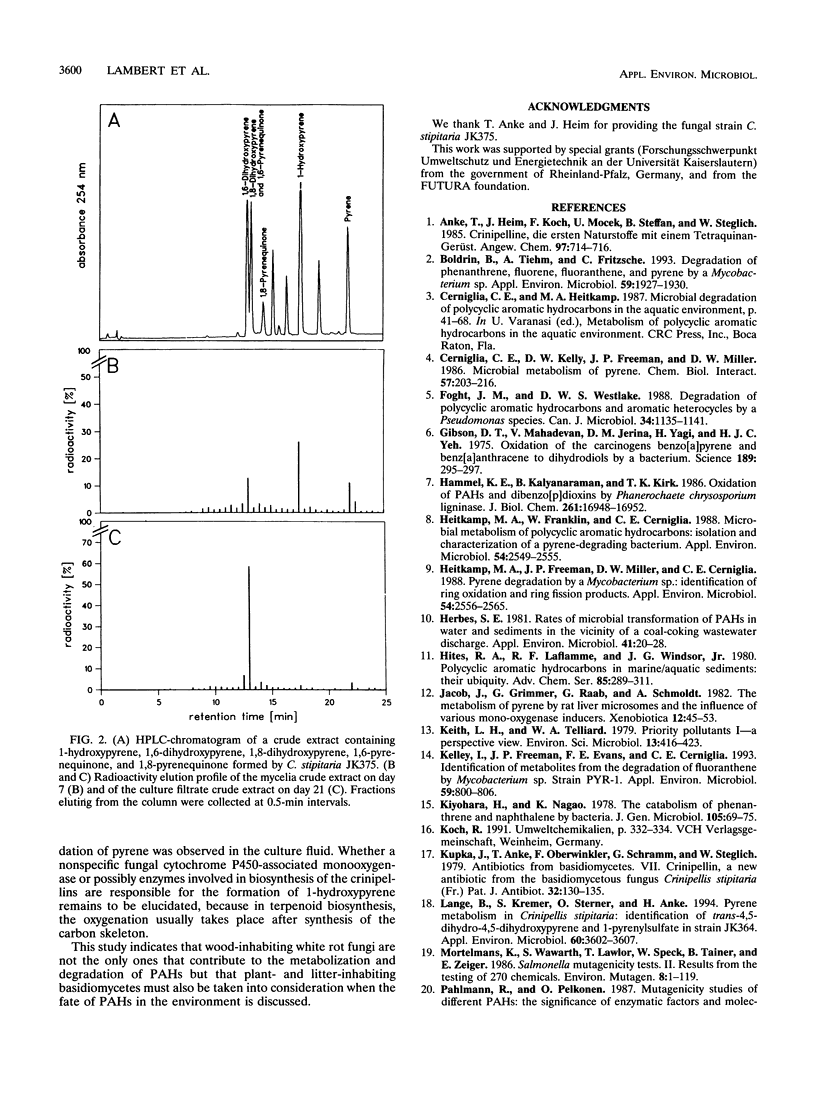Abstract
The metabolism of pyrene, a polycyclic aromatic hydrocarbon, by submerged cultures of the basidiomycete Crinipellis stipitaria was studied. After incubation for 68 h at 25°C in a 20-liter fermentor with complex medium and 20 mg of pyrene per liter, five metabolites were detected. The compounds were isolated by preparative high-performance liquid chromatography on RP18 and DIOL gels. By UV, infrared, and 1H nuclear magnetic resonance spectroscopy and mass spectrometry, 1-hydroxypyrene, 1,6-dihydroxypyrene, 1,8-dihydroxypyrene, 1,6-pyrenequinone, and 1,8-pyrenequinone were identified. 1,6- and 1,8-dihydroxypyrene were obtained from fungal cultures for the first time. The formation of these metabolites was confirmed by investigations with [4,5,9,10-14C]pyrene.
Full text
PDF




Selected References
These references are in PubMed. This may not be the complete list of references from this article.
- Boldrin B., Tiehm A., Fritzsche C. Degradation of phenanthrene, fluorene, fluoranthene, and pyrene by a Mycobacterium sp. Appl Environ Microbiol. 1993 Jun;59(6):1927–1930. doi: 10.1128/aem.59.6.1927-1930.1993. [DOI] [PMC free article] [PubMed] [Google Scholar]
- Cerniglia C. E., Kelly D. W., Freeman J. P., Miller D. W. Microbial metabolism of pyrene. Chem Biol Interact. 1986 Feb;57(2):203–216. doi: 10.1016/0009-2797(86)90038-4. [DOI] [PubMed] [Google Scholar]
- Foght J. M., Westlake D. W. Degradation of polycyclic aromatic hydrocarbons and aromatic heterocycles by a Pseudomonas species. Can J Microbiol. 1988 Oct;34(10):1135–1141. doi: 10.1139/m88-200. [DOI] [PubMed] [Google Scholar]
- Gibson D. T., Mahadevan V., Jerina D. M., Yogi H., Yeh H. J. Oxidation of the carcinogens benzo [a] pyrene and benzo [a] anthracene to dihydrodiols by a bacterium. Science. 1975 Jul 25;189(4199):295–297. doi: 10.1126/science.1145203. [DOI] [PubMed] [Google Scholar]
- Hammel K. E., Kalyanaraman B., Kirk T. K. Oxidation of polycyclic aromatic hydrocarbons and dibenzo[p]-dioxins by Phanerochaete chrysosporium ligninase. J Biol Chem. 1986 Dec 25;261(36):16948–16952. [PubMed] [Google Scholar]
- Heitkamp M. A., Franklin W., Cerniglia C. E. Microbial metabolism of polycyclic aromatic hydrocarbons: isolation and characterization of a pyrene-degrading bacterium. Appl Environ Microbiol. 1988 Oct;54(10):2549–2555. doi: 10.1128/aem.54.10.2549-2555.1988. [DOI] [PMC free article] [PubMed] [Google Scholar]
- Heitkamp M. A., Freeman J. P., Miller D. W., Cerniglia C. E. Pyrene degradation by a Mycobacterium sp.: identification of ring oxidation and ring fission products. Appl Environ Microbiol. 1988 Oct;54(10):2556–2565. doi: 10.1128/aem.54.10.2556-2565.1988. [DOI] [PMC free article] [PubMed] [Google Scholar]
- Herbes S. E. Rates of microbial transformation of polycyclic aromatic hydrocarbons in water and sediments in the vicinity of a coal-coking wastewater discharge. Appl Environ Microbiol. 1981 Jan;41(1):20–28. doi: 10.1128/aem.41.1.20-28.1981. [DOI] [PMC free article] [PubMed] [Google Scholar]
- Jacob J., Grimmer G., Raab G., Schmoldt A. The metabolism of pyrene by rat liver microsomes and the influence of various mono-oxygenase inducers. Xenobiotica. 1982 Jan;12(1):45–53. doi: 10.3109/00498258209052453. [DOI] [PubMed] [Google Scholar]
- Kelley I., Freeman J. P., Evans F. E., Cerniglia C. E. Identification of metabolites from the degradation of fluoranthene by Mycobacterium sp. strain PYR-1. Appl Environ Microbiol. 1993 Mar;59(3):800–806. doi: 10.1128/aem.59.3.800-806.1993. [DOI] [PMC free article] [PubMed] [Google Scholar]
- Kupka J., Anke T., Oberwinkler F., Schramm G., Steglich W. Antibiotics from basidiomycetes. VII. Crinipellin, a new antibiotic from the basidiomycetous fungus Crinipellis stipitaria (Fr.) Pat. J Antibiot (Tokyo) 1979 Feb;32(2):130–135. doi: 10.7164/antibiotics.32.130. [DOI] [PubMed] [Google Scholar]
- Lange B., Kremer S., Sterner O., Anke H. Pyrene Metabolism in Crinipellis stipitaria: Identification of trans-4,5-Dihydro-4,5-Dihydroxypyrene and 1-Pyrenylsulfate in Strain JK364. Appl Environ Microbiol. 1994 Oct;60(10):3602–3607. doi: 10.1128/aem.60.10.3602-3607.1994. [DOI] [PMC free article] [PubMed] [Google Scholar]
- Mortelmans K., Haworth S., Lawlor T., Speck W., Tainer B., Zeiger E. Salmonella mutagenicity tests: II. Results from the testing of 270 chemicals. Environ Mutagen. 1986;8 (Suppl 7):1–119. [PubMed] [Google Scholar]
- Phillips D. H. Fifty years of benzo(a)pyrene. Nature. 1983 Jun 9;303(5917):468–472. doi: 10.1038/303468a0. [DOI] [PubMed] [Google Scholar]
- Pothuluri J. V., Heflich R. H., Fu P. P., Cerniglia C. E. Fungal metabolism and detoxification of fluoranthene. Appl Environ Microbiol. 1992 Mar;58(3):937–941. doi: 10.1128/aem.58.3.937-941.1992. [DOI] [PMC free article] [PubMed] [Google Scholar]
- Weissenfels W. D., Beyer M., Klein J. Degradation of phenanthrene, fluorene and fluoranthene by pure bacterial cultures. Appl Microbiol Biotechnol. 1990 Jan;32(4):479–484. doi: 10.1007/BF00903787. [DOI] [PubMed] [Google Scholar]


